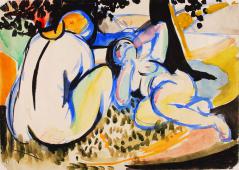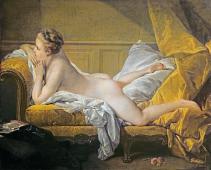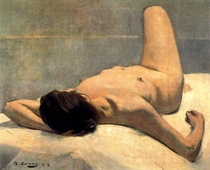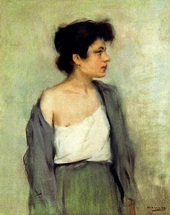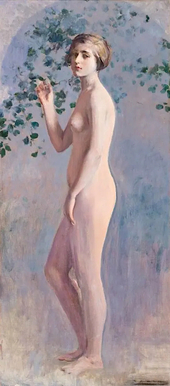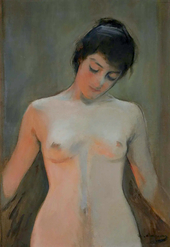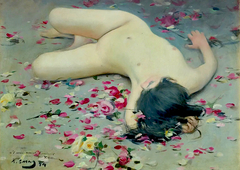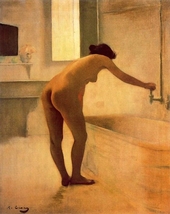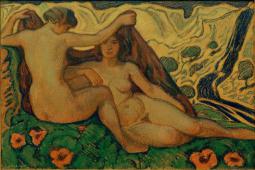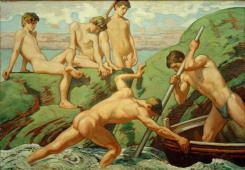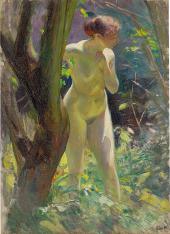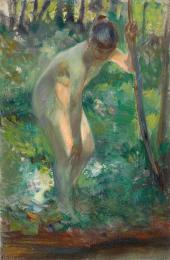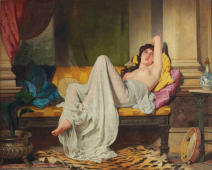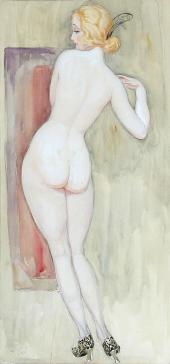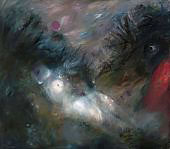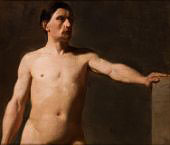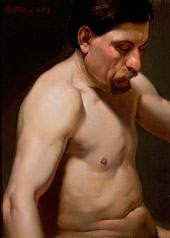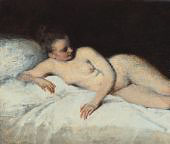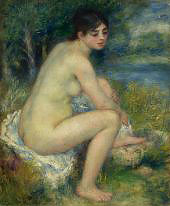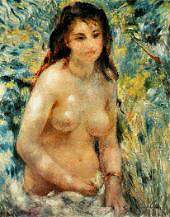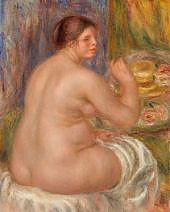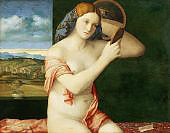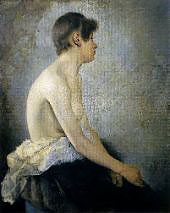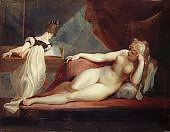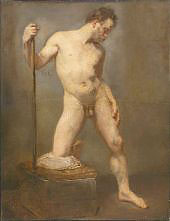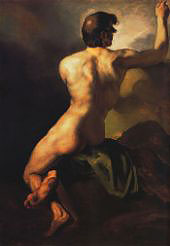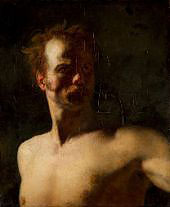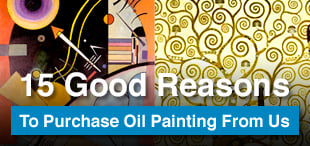Famous Nude Paintings: A Brief Introduction
Buy your oil painting reproductions of famous nudes here.
Famous Nude Paintings
Nude paintings, mainly depicting the female form, are a Western art phenomenon. It became particularly prevalent during the Renaissance art period when a revived interest in Roman and Greek culture transformed artistic production.
Despite this, representations of the nude human body have been a significant theme in art ever since prehistoric times, when we first learned to make marks and carve objects. The naked body stands for beauty, dreams, and forbidden desire. It also causes scandal and delight in equal measure.
Here is a brief introduction to the history of nude art, including some of the most famous nude paintings and artists pushing the boundaries of sexuality, femininity, and cultural norms.
What was the First Nude Oil Painting?
The first nude oil painting is a topic of intense scholarly debate. Despite this, early nude paintings include objects like the Venus of Willendorf. She was sculpted around 30,000 years ago, depicting a naked female form. Theories abound on its purpose, with suggestions including fertility deities, mother goddesses, or a female self-portrait.
With the advent of Christianity in Europe, nude paintings and sculptures created purely for their beauty declined. With an emphasis on religious chastity and celibacy, few carefully observed nude paintings in Medieval Art appeared. While notable exceptions included depictions of Adam and Eve and the naked baby Jesus, Greco-Roman nude paintings represent sinful desires.
However, this changed in 13th century Italy when famous artists such as Donatello used Greek athletic figures for inspiration. Most famously represented in his celebrated statue of David, Donatello’s work influenced other artists, such as Michelangelo. Michelangelo’s famous frescoes on the Sistine Chapel ceiling imbue the nude male form with previously unseen realism and beauty.
Renaissance Nude Art
During the Renaissance Art period, from the 14th to the 17th centuries, female nude forms were a massive inspiration due to increased interest in Greek and Roman mythology.
Renaissance artists particularly favored paintings of Venus. For instance, Titian’s Venus of Urbino and Leonardo da Vinci’s Leda and the Swan seductively portray mythological female nude subjects. These oil paintings are referenced in Sandro Botticelli’s Birth of Venus but steer away from more overtly erotic depictions such as Venus, Cupid, Folly, and Time by Agnolo Bronzino.
Despite these new and exciting nude oil paintings, Renaissance art represents nude paintings as glorified but heavily controlled. They are always mythological or Religious art subjects rather than simple naked bodies.
In Northern Europe, female nude paintings also grew in popularity. Similar to Italian Renaissance artists, Lucas Cranach’s Judgement of Paris also takes inspiration from classical sources. For example, many artists, such as Albrecht Durer, focus on stricter Christian narratives, such as the story of Adam and Eve.
Who painted the Naked Maja?
The increased use of nude models during Renaissance art caused significant controversy. Nonetheless, the tradition of nude oil paintings continued, with Spain becoming a particular hotspot of artistic excellence. Francisco de Goya’s Nude Maja or The Naked Maja (La Maja Desnuda) shocked the Catholic Church.
Francisco Goya's famous nude painting did not rely on mythological or religious explanations and was banned for its explicit portrayal of the female anatomy. Goya's oil painting depicts a naked woman in all her beauty. As a result, the artist was involved in a lengthy legal trial led by the Spanish Inquisition, and he was only saved by the intervention of Cardinal Don Luis María de Borbón y Vallabriga.
Other Spanish painters like Diego Velazquez stuck to more classical mythological subjects. His Venus at her Mirror, also known as the Rokeby Venus, was Velazquez's only famous nude painting. Despite the mirror held by Cupid, the woman’s face is not visible, allowing Velazquez to ensure that Venus, the ultimate personification of female beauty, is not identifiable as a woman.
What are Classical Nude Paintings?
The pioneering oil paintings of Francisco de Goya pushed nude art into everyday reality. However, the female nude gained new meaning with paintings by Peter Paul Rubens. His fleshy and generous figures portrayed in paintings such as Ceres and Two Nymphs personified the new Classical and Baroque approaches to nude artwork.
Classicism paintings enjoyed a second renaissance during the late 18th and early 19th centuries. Nude paintings gained new prestige, with traditional art academies and teaching institutions encouraging young artists to study Greek and Roman sculpture and live models. This resulted in works such as Alexandre Cabanel’s Birth of Venus and William-Adolphe Bouguereau’s The Wave, which rely on heavily controlled classical forms.
Nonetheless, famous artists such as Jean-Auguste Dominique Ingres challenged these norms. With a Mannerist approach, his nude paintings, such as La Grande Odalisque, deliberately elongate the female form to promote “ideal,” artistically created notions of beauty.
This led to later British painters such as Frederic Lord Leighton confidently portraying nude bodies for their beauty alone. Indeed, Leighton’s Standing Nude Figure Seen from Behind 1880 depicts an undressed woman freed from the shackles of previous reclining nude Venus paintings.
What are Impressionist nude paintings?
Returning to France, Impressionist, Realist, and Post-Impressionist artists again drove nude painting forward.
With the decline of classical and academic approaches, artists like Edouard Manet enraged public sensibilities with contemporary nudes. In Le Dejeuner sur l’herbe, a naked woman reclines in a distinctly modern setting. Her nudity is even more evident in the setting of the two smartly dressed, fully clothed men in the painting.
While Edouard Manet retained some vestige of classical approaches, Gustav Courbet engendered bitter criticism for his nude paintings of women. He rejected overly smoothed and stylized nudes, priding himself on strict realism. His shockingly realistic Origin of the World, also known as L’Origine du Monde, and erotic lesbian art, such as Le Sommeil, stood for the “hidden parts” of femininity that even Manet didn’t dare show.
Despite this progression, many Post-Impressionist and Impressionist paintings use broadly traditional approaches to nude art. This includes Renoir’s Bather Series and Edgar Degas’ depictions of women washing. Both famous Impressionist artists follow the long tradition of undressed women near water, unaware of the viewer’s gaze.
Paul Gauguin updated the reclining nude format with oil paintings such as The Spirits of the Dead Keep Watch, where although the woman reclines in a domestic setting, she confidently and unswervingly gazes out from the pictorial space.
Who painted modern nude paintings?
In the 20th century, pioneering artists such as Henri Matisse, Pablo Picasso, and Egon Schiele depicted nude forms from a new perspective.
In paintings such as Les Demoiselles d’Avignon, Picasso uses Cubist principles to pull apart and reimagine the female form. Indeed, Cubism shattered earlier restrictions, free from mythological narratives and realistic figurative depictions. While more traditional representations continued, for instance, oil paintings by Ramon Casas or Isaac Israels, the contemporary nude was never the same.
Amedeo Modigliani was another trailblazer of nude paintings, reinterpreting classical nudes in his unique artistic style. Indeed, Modigliani’s Le Grande Nu plays on Ingres’ Grande Odalisque while incorporating bright, bold shapes and forms. Like Picasso, Amedeo Modigliani’s nude paintings exist without allegorical context, moving the female body away from religious and mythological narratives ever closer to pure sensuality and eroticism.
This trend culminates with the work of Egon Schiele, a painter famed for the raw sexuality of his works. Inspired by prostitutes and lovers, Schiele painted naked, gaunt, and often distorted bodies. Like many artists, including Francisco Goya and Amedeo Modigliani, Egon Schiele almost served time in prison. Drawings such as Naked Girls Embracing insulted the morality values of the time, leaving the complex links between sex, death, pleasure, and pain bare for all to see.
Fine Art Oil Paintings: Nude Wall Art
Buy museum quality oil paintings on canvas, and explore our vast collection of famous nude paintings. With fine art reproductions from Titian, Alexandre Cabanel, Egon Schiele, and Edouard Manet, discover beautiful female nude paintings to enrich your walls.
Cannot Find What You Are Looking For?
Reproduction Gallery Information
Customer Service
(Send Us A Message)
Tel: (503) 937 2010
Fax: (503) 937 2011




